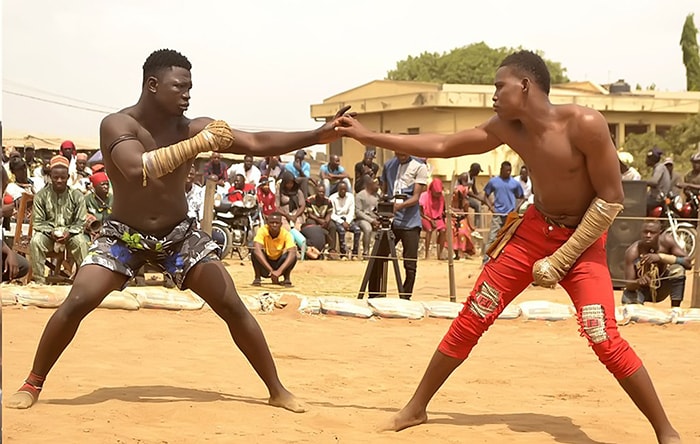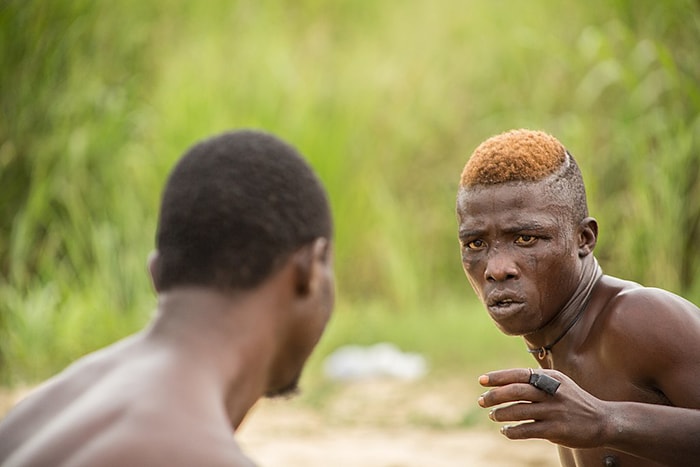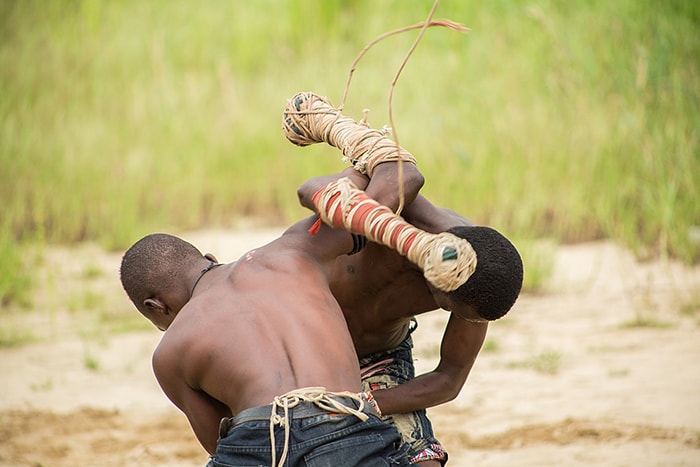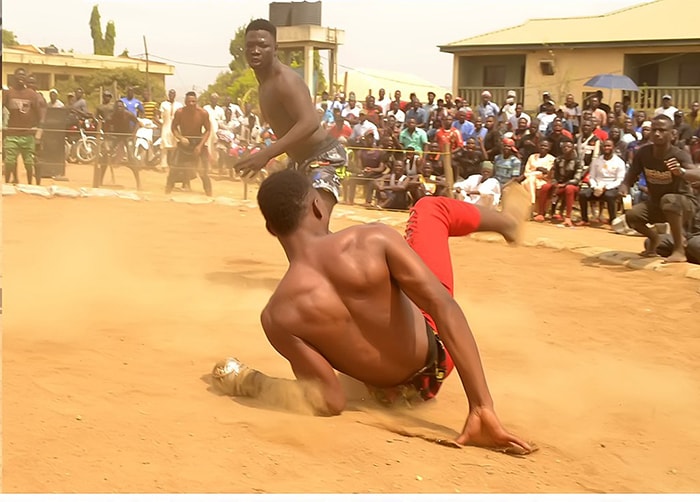Dambe: The Nigerian Martial Art of the Hausa People
Welcome to the African sport of Dambe, a traditional martial art style that originated in Nigeria. It’s a unique combat sport that primarily involves boxing with one hand wrapped in a cloth (known as the “spear”) while the other hand is used for defense (called the “shield”). Fighters also use kicks, and for this reason, Dambe has been compared to kickboxing or boxing, but without the gloves.
Dambe competitions are engulfed in rituals and traditions, and in this article, we are going to dive into the history of Dambe as well as the unique attributes of the African sport. Join us as we explore the mesmerizing world of Dambe!
Origins and History of Dambe

Dambe is an ancient sport with a rich history spanning centuries. It was originally created by the Hausa people in West Africa, particularly Nigeria, and has mostly been practiced by them since its creation. The Hausa people are one of the largest ethnic groups in Africa, and Dambe is a traditional sport full of their traditions and practices.
Dambe dates back over 200 years to a time when it was once practiced by the butchers’ guild known as “Yan Dambe” during their post-harvest downtime. Traditionally, it was practiced by butchers during harvest festivals as a way to demonstrate strength and skill. The festivals took place as a way to invite outsiders into their culture and entertain them with displays of the Hausa culture.
Although it originated as a localized practice, Dambe has now spread across Nigeria and West Africa, becoming a popular form of entertainment at festivals. Dambe, in modern times, has gained international recognition through social media and various documentaries, showcasing its unique fighting techniques and cultural significance.
Unique Features of Dambe

Dambe distinguishes itself through distinctive rituals and unique fighting styles, including the use of one dominant hand wrapped in cloth for striking. It intertwines historical practices with techniques reminiscent of boxing, presenting a unique blend that reflects the Nigerian cultural heritage with modern martial arts.
One of the most defining features of Dambe involves a single-armed fighter with their dominant hand wrapped in a cloth, known as “kurmi.” The wrapped hand is known as the “spear,” and it is used to deliver strikes, while the weaker, unwrapped hand is used as a shield to defend against attacks. This is quite an unusual feature of any martial art or combat sport, as it puts fighters at a disadvantage in some ways. Kicks are also allowed in Dambe and are sometimes even used to achieve knockouts.
Another defining feature is that there is no time limit for rounds; there are three rounds, and the only way to end a round is to cause your opponent’s body to touch the ground. This is usually achieved by a knockout, which means the only real way of winning Dambe matches is by knockout (KO) or a technical knockout (TKO).
If all three rounds go the distance, the judges will score it based on points for the fighter who scored the most knockouts. The only other combat sport with a ruleset like this is Burmese bare-knuckle boxing, also known as Lethwei. The constant need for a knockout means Dambe is a very intense and hard-fought combat sport.
Techniques of Dambe Fighting Style

Dambe techniques are quite similar to those of boxing and kickboxing. They essentially use the same techniques but perform them in a different way, as the rules only allow Dambe fighters to use the strong hand. Here are some of the techniques used:
- Jab (Spear Hand):
- Quick, straight punches using the wrapped, striking hand.
- Hook (Spear Hand):
- Curved punches aimed at the side of the opponent’s head or body. Hooks are utilized well in Dambe, and knockouts by hooks can be seen often.
- Uppercut (Spear Hand):
- Upward punches target the opponent’s chin or midsection.
- Cross (Spear Hand):
- Powerful, straight punches aimed at the head or body. This is one of the most common strikes in Dambe.
- Low Kicks (Shield Leg):
- Kicks are usually directed below the waist, targeting the opponent’s legs to destabilize them. However, head kicks are also allowed in Dambe, and sometimes head kick knockouts are seen too.
- Defensive Blocking (Shield Hand):
- Using the non-striking hand to block or parry incoming strikes.
- Evasion and Footwork:
- Quick movements to dodge attacks and positioning to maintain balance and counterattack.
These techniques in practice do not look the same as boxing or kickboxing versions of the techniques. This is because Dambe fighters train without boxing gloves and aim for the knockout at all times, which means they practice the techniques in a different way to adapt them to their sport.
The Role of Dambe Warriors
A Dambe warrior is a practitioner of the martial art and somebody who takes part in Dambe fights. Dambe warriors are an essential part of the sport, as they often travel across Nigeria to take part in festivals. As fights became more popular on YouTube, the sport’s popularity skyrocketed, and teams of fighters began traveling all over Nigeria to compete in festivals.
These well-respected fighters provide entertainment at cultural events and are often celebrated in Nigerian society. Victorious fighters in Dambe often receive a range of payouts and gifts from spectators, highlighting the financial rewards and personal gains associated with their success. Although Dambe hasn’t reached a worldwide level of fame yet, it has gathered a solid fanbase in Africa, and Dambe fights are often highly anticipated.
Dambe in Modern Times

Although Dambe is a traditional martial art that is fast adapting to the modern world, drawing in an overwhelming number of viewers on online platforms. The sport has not only gained more popularity within Nigeria but also globally, with over 60% of Dambe’s views now coming from outside Nigeria. Dambe fighters are finally getting the world-wide recognition they have fought so hard for.
Dambe promoter Anthony Okeleke aims to take the sport to new heights worldwide and establish regulations for the sport, comparable to those used by MMA or boxing governing bodies.. Although this may make the sport more established, it might take away from the freestyle elements of Dambe. Either way, Dambe is becoming more and more renowned, and it has become the cornerstone of African martial arts.
Summary
Internet and social media have contributed to the combat sport of Dambe’s recent surge in popularity. For many people in West Africa and beyond, the sport of Dambe is a source of pride, identity, and tradition. Dambe is a martial art that reflects the cultural heritage and distinctive pugilistic tradition of West Africa, with a promising future ahead.
Frequently Asked Questions
What are the rules of Dambe?
The basic rules of Dambe are to score points by landing effective strikes with one arm, which is wrapped in rope, while the other arm is used for defense. Kicks are also allowed. Matches end either by knockout or by judges’ decisions based on performance.
Are kicks allowed in Dambe?
Yes, kicks are allowed in Dambe. Fighters use them alongside their dominant fist to strike and control their opponent; however, the use of kicks is usually less frequent than punches.
Who invented Dambe?
Dambe, an ancient sport, was invented by the Hausa butchers of Nigeria.
What can fighters earn from winning a Dambe boxing match?
Fighters in a Dambe match can earn prize money, trophies, and sponsorships. Victories can also enhance their reputation within the martial arts community, potentially leading to further opportunities in the future.









